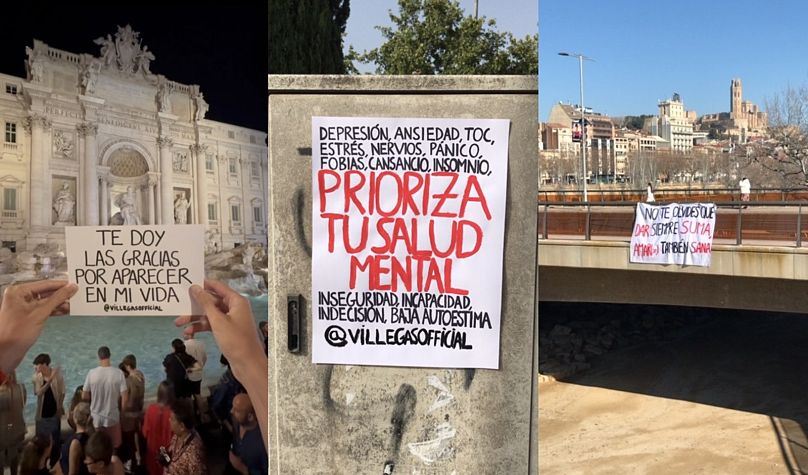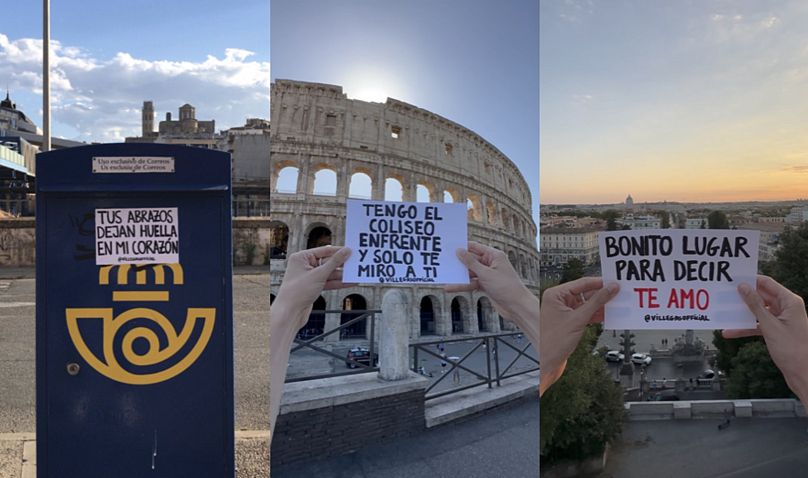Euronews Culture speaks to Jordi Villegas, the 28-year-old street artist peppering Europe's streets with messages telling passers-by how they should feel about the places they're visiting - and themselves.
Some things are better left unsaid, as the old adage goes.
Not for one man, however.
Meet Jordi Villegas, the young Spanish street artist who has been peppering European cities with messages written in his mother tongue, telling the public the unspoken truths about the places they're visiting - and how they should feel about their lives.
Over at Rome's Pincian terrace - an iconic spot for doe-eyed couples to admire the Eternal City's oneiric panorama - his sticker informs passers-by that it is a "pretty place to say I love you".
On a mailbox in Spain, he tapped into the minds and hearts of many separated from their loved ones: "I don't want to write to you: I want to see you", the message reads.
Such romantic maxims have already struck a chord with many online: Villegas has racked up tens of thousands of followers on social media platforms.
Is Villegas's messaging a form of tongue-in-cheek humour, a playful parody of the romantic tropes and clichés associated with well-trodden tourist spots? Or is the artist trying to bring back an unabashed, youthful romanticism to Europe's streets? Euronews Culture asks the man himself.
The man behind the words: Who is Jorge Villegas?
Villegas, 28, traces his roots to the town of Lleida, not too far from Barcelona, where he first decided to start posting his inspirational messages six years ago.
"I've been writing for years, I love creating removable messages, and making people's day happier," he told Euronews Culture.
"But this initiative, that of putting up posters, is one I saw as a different thing - it's making art for people. I did it, and it started as a result of a message that I wanted to write about self-love and mental health."
Villegas's work seamlessly combines street art and social media messaging, straddling the line between the two. His stickers are posted on the walls and the apps alike, all replete with his Instagram handle - a signature, a watermark, and a shrewd marketing strategy all wrapped into one.
Some of his messages are pithy, rather indistinct self-help platitudes: "Prioritise your mental health", "If you read this, remember that I love you", and so on.
Others espouse a nostalgic, quasi-cinematic romanticism, playing on the iconography of specific locations and objects.
"I have the Colosseum in front of me and I'm only looking at you", one sticker reads, posted in front of Rome's 1,943-year-old amphitheatre and signature landmark. As for a decidedly less colossal backdrop: "Tell her you love her/him/them", scribbled on the handset of a telephone box.
A handful of works even veer into the realm of conceptual or performance art. One sign, saying "Life slides away like water, there are those who only look for fire", was set alight, and the video posted on his online channels.
But Villegas's work is largely free from specific artistic technique or mastery, relying solely on the message at its core.
Indeed, one could muse over which specific label best describes the nature of Villegas's work: "street art", "street poetry", or merely a more public form of self-help messaging. But he eschews such narrow categorisations.
"I consider myself a person like everyone else, free in my actions, decisions and with the freedom to express myself," he told Euronews Culture. "And the best way of expressing myself is by writing, writing for society, for the people, for those who find me on the streets. I would just like to be recognised over time as the writer of such phrases and posters."
All this notwithstanding, Villegas clearly identifies his work as 'art', and has no issue identifying his favourite creation so far.
"The one I liked the most was a sheet I put on a bridge in my city on Valentine's Day that said: 'No te olvides que dar siempre suma, amar(se) también sana' ('Don't forget that giving always bears fruit, loving (oneself / each other) is healthy too')", he stated.
A growing social media presence
While Villegas's work could once only be found in his Catalan homeland, the young creative - spurred by the warm reception his work has received - has now branched out of Spain to other European capitals, namely Paris, Rome and Lisbon, where he has posted over 60 stickers.
"I saw that the initiative contributed to society, people took my phrases as a form of help and I decided to continue with this."
And his creations have started resonating with the public.
Villegas has amassed over 28,000 followers on Instagram and nearly 25,000 on TikTok, with his two pinned videos gaining over one million views each.
Responses from fans and other enthusiasts of his work has been encouraging to say the least. His videos are lined with strings of countless messages of support.
"Many people have written to me and told me that the phrase [they saw] was made for them, that such phrase is what they needed to read that very day. It seems that they are creating a healing process in some cases, and that touches me.
His favourite response so far?
"The phrase that I liked the most was: 'Every morning before going to work and accompanying my children to school, we pass in front of [your] poster to read it.'"
"Other messages that I have liked have been: 'I am going to visit Spain to see your phrases', or 'I would love for you to put some phrase in Chile'."
'A place to say I love you': Ironic wit or unrepentant romanticism?
Taken at face value, Villegas's stickers brim with hope, optimism and a zest for life. Free from any hints of cynicism, they are an unbridled celebration of love and all it has to offer.
But, as with many works of art, one is left wondering whether to read beyond the lines to discover an underlying message.
The blatant romanticism of his stickers, especially when juxtaposed with their recognisable backdrops, could also appear to mock the hackneyed symbolism of modern-day romance.
From the majestic - the Colosseum and Trevi fountain - to the minute - a mailbox and phone box - Villegas posts his work on objects that have become well-identified tropes of romantic iconography and "nostalgia porn".
Take the mailbox, for instance: it's the central image of romance novel 'Every Breath', written by none other than king of tearjerkers, Nicholas Sparks.
Or the telephone box: the backdrop of many-a music video and film.
Indeed, social media - Villegas's main platform - is saturated with content playing on such clichés, often with commercial goals. The "travel blogger" or "influencer", who will undoubtedly post a picture in iconic urban spots, is now a potentially lucrative business.
But Villegas confirms his work is free of intentional irony or satire: rather, it is meant to elicit positive emotions.
"When I travelled to Rome, I wrote many phrases which really related to the concept of romanticism," he told Euronews Culture. "I thought that the best place to put it was in a part where all of Rome could be seen, or for example in Trevi fountain."
"I didn't do it to romanticise the place," he added, "but because I think that many people, may couples, go to places like this, to contemplating those views. Reading that message is like something ideal for [such] people."
Rome: Where inspiration springs eternal
Villegas's stickers now grace the streets of several cities across Europe. But few hold as dear a place in his heart as the Eternal City itself.
"It is and will [forever] be a special, magical city, full of history and art," he told Euronews Culture. "And I obviously wanted to leave my small mark of art in this city, with different messages of love, mental health and motivation."
"I went to travel around Italy as a child and I have always wanted to return, and now that the opportunity arose, I wanted to do something special for all the people of Rome," he added.
And Rome is no stranger to people leaving their mark on the city's streets: from ancient Roman graffiti, to the "Pasquinades" - satirical poems posted nearby the statue of the same name - and modern-day teens scribbling professions of love over the city's walls.
The Italian capital is clearly a major source of inspiration for the budding young creative. But as for how he posits himself among a legion of other aspiring artists and poets sharing and where his inspirations lie, he cites few sources of inspiration.
"Honestly, when I started writing, I did it as a result of some word I heard, some feeling that I visualised in conversations with friends, and I wanted to express it using the written word," he stated. "People always stimulate you, but there is no better inspiration than yourself when you are the creator of your art."
Notably devoid from any self-descriptions are any political themes, which may seem a contradiction given how few are as intrinsically political as street art.
Banksy - the street artist par excellence, and a idol of Villegas's - has lampooned and depicted a wide range of social issues in his stencils. Not only does street art often take and transcribe the pulse of society, but it remains a political art form at its very core - especially when one considers that many forms of street art, graffiti in particular, veer on the border of illegality.
Not for Villegas.
"In the approximately 60 creations that I have made, there isn't a single one that talks about politics", he said. "That's not my thing. I don't think it's a topic I have to get into. But I do believe that my goal is on the path towards creating a social message."
The 28-year-old wordsmith may not be out here to make a revolutionary statement. But amid a horde of artists who feel an obligation - a duty, even - to critique, to condemn, to imbue their work with political depth, Villegas' rejection of such canons feels like a statement in its own form.
"I hope to become an artist for the good of society, be it for motivational, self-love, healing, mental health, purposes," he emphasised. "After all, my phrases [can] help when the person who reads them empathises and sees that the phrase is made for them."
In embracing radical gratitude and an unabashed romantic optimism, he has left his own distinct mark: one that might warm the heart of a a Europe worn out by years of the pandemic and economic vicissitudes.
"I want to give space, give light, to topics that do us good," he concluded. "My job is to write them out to make them visible in the streets of this wonderful world."













